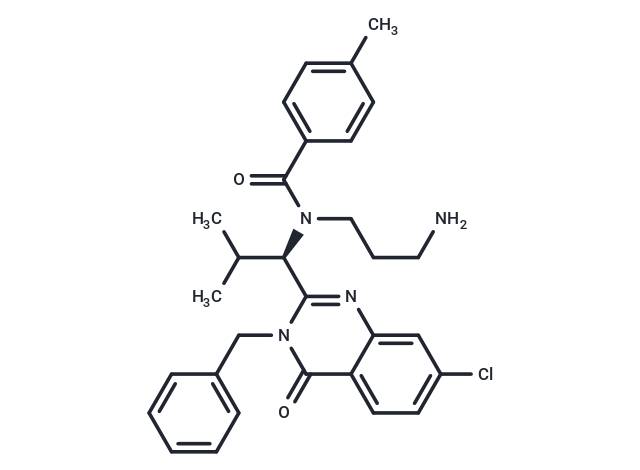Shopping Cart
- Remove All
 Your shopping cart is currently empty
Your shopping cart is currently empty

Ispinesib (SB-715992), a selective, effectvie and reversible inhibitor of kinesin spindle protein (KSP), is derived from quinazolinone, with antineoplastic properties.

| Pack Size | Price | Availability | Quantity |
|---|---|---|---|
| 1 mg | $33 | In Stock | |
| 2 mg | $46 | In Stock | |
| 5 mg | $72 | In Stock | |
| 10 mg | $121 | In Stock | |
| 25 mg | $222 | In Stock | |
| 50 mg | $356 | In Stock | |
| 100 mg | $587 | In Stock | |
| 500 mg | $1,280 | In Stock | |
| 1 mL x 10 mM (in DMSO) | $82 | In Stock |
| Description | Ispinesib (SB-715992), a selective, effectvie and reversible inhibitor of kinesin spindle protein (KSP), is derived from quinazolinone, with antineoplastic properties. |
| Targets&IC50 | KSP (HsEg5):1.7 nM(Ki app) |
| In vitro | In PC-3 prostate cancer cells, Ispinesib (5 nM and 30 nM) inhibited cell proliferation and induced apoptosis by modulating the level of gene expression of signals. In breast cancer cell lines, Ispinesib (7.4 nM-600 nM) exhibited broad-spectrum inhibitory activity. In tumor cell lines (Colo205, Colo201, HT-29, M5076, Madison-109, and MX-1), Ispinesib (IC50=1.2-9.5 nM) is highly cytotoxic. |
| In vivo | In PC-3 prostate cancer cells, Ispinesib (5 nM and 30 nM) inhibited cell proliferation and induced apoptosis by modulating the level of gene expression of signals. In breast cancer cell lines, Ispinesib (7.4 nM-600 nM) exhibited broad-spectrum inhibitory activity. In tumor cell lines (Colo205, Colo201, HT-29, M5076, Madison-109, and MX-1), Ispinesib (IC50=1.2-9.5 nM) is highly cytotoxic. |
| Kinase Assay | Steady-State Kinetic Analysis of Human KSP ATPase Activity and Inhibition by Ispinesib: Kinesin specificity analysis is carried out using a pyruvate kinase-lactate dehydrogenase detection system that couples the production of ADP to oxidation of NADH. Absorbance changes are monitored at 340 nm. Steady-state studies using nanomolar concentrations of KSP are performed using a sensitive fluorescence-based assay utilizing a pyruvate kinase, pyruvate oxidase, and horseradish peroxidase (HRP) coupled detection system that couples the generation of ADP to oxidation of Amplex Red to fluorescent resorufin. Generation of resorufin is monitored by fluorescence (λexcitation = 520 nm and λemission = 580 nm). Steady-state biochemical experiments are performed in PEM25 buffer [25 mM Pipes-K+ (pH 6.8), 2 mM MgCl2, 1 mM EGTA] supplemented with 10 μM paclitaxel for experiments involving microtubules. The IC50 for steady-state inhibition is determined at 500 μM ATP, 5 μM Microtubules, and 1 nM KSP in PEM25 buffer. Ki app (apparent inhibitor dissociation constant) values of Ispinesib are extracted from the dose-response curves, with explicit correction for enzyme concentration by using the Morrison equation. Inhibitor modality (e.g., competitive, noncompetitive, uncompetitive, or mixed) under steady-state conditions is determined by measuring the effect of inhibitor concentration on initial velocity as a function of substrate concentrations. Data are fit using equations in GraFit to velocity equations for the various modes of inhibition. |
| Cell Research | Cells are plated in log phase of growth in 96-well plates and treated with Ispinesib for 72 hours. Then, cell growth is measured using CellTiter-Glo, and luminescence is detected using BioTek FLx800. Data are analyzed and the IC50 value, defined as the drug concentration that results in 50% growth inhibition relative to control, is calculated.(Only for Reference) |
| Alias | SB-715992, CK0238273 |
| Molecular Weight | 517.06 |
| Formula | C30H33ClN4O2 |
| Cas No. | 336113-53-2 |
| Smiles | CC(C)[C@@H](N(CCCN)C(=O)c1ccc(C)cc1)c1nc2cc(Cl)ccc2c(=O)n1Cc1ccccc1 |
| Relative Density. | 1.216g/cm3 |
| Storage | Powder: -20°C for 3 years | In solvent: -80°C for 1 year | Shipping with blue ice. | |||||||||||||||||||||||||||||||||||
| Solubility Information | Ethanol: 95 mg/mL (183.73 mM), Sonication is recommended. DMSO: 95 mg/mL (183.73 mM), Sonication is recommended. | |||||||||||||||||||||||||||||||||||
Solution Preparation Table | ||||||||||||||||||||||||||||||||||||
Ethanol/DMSO
| ||||||||||||||||||||||||||||||||||||

Copyright © 2015-2025 TargetMol Chemicals Inc. All Rights Reserved.